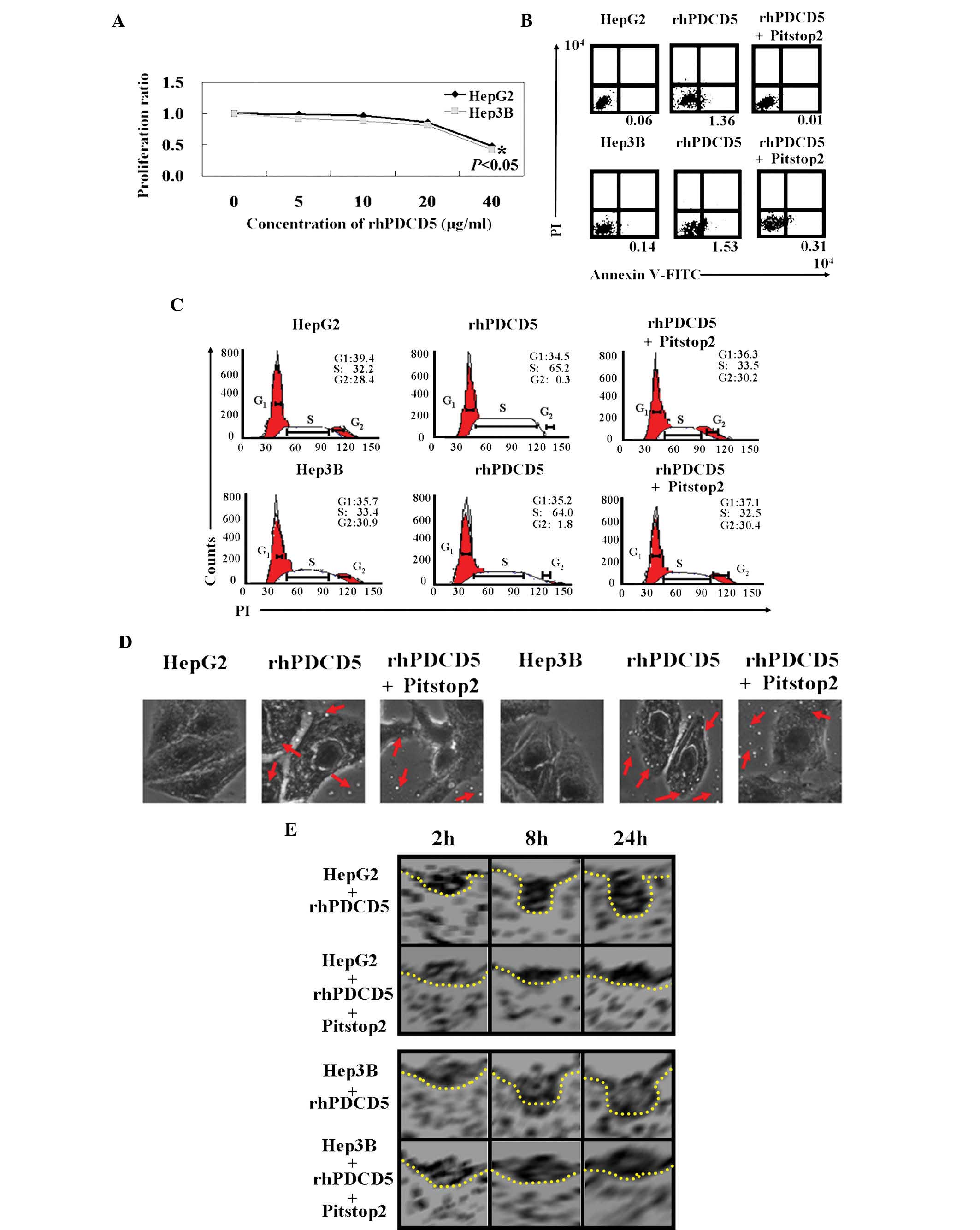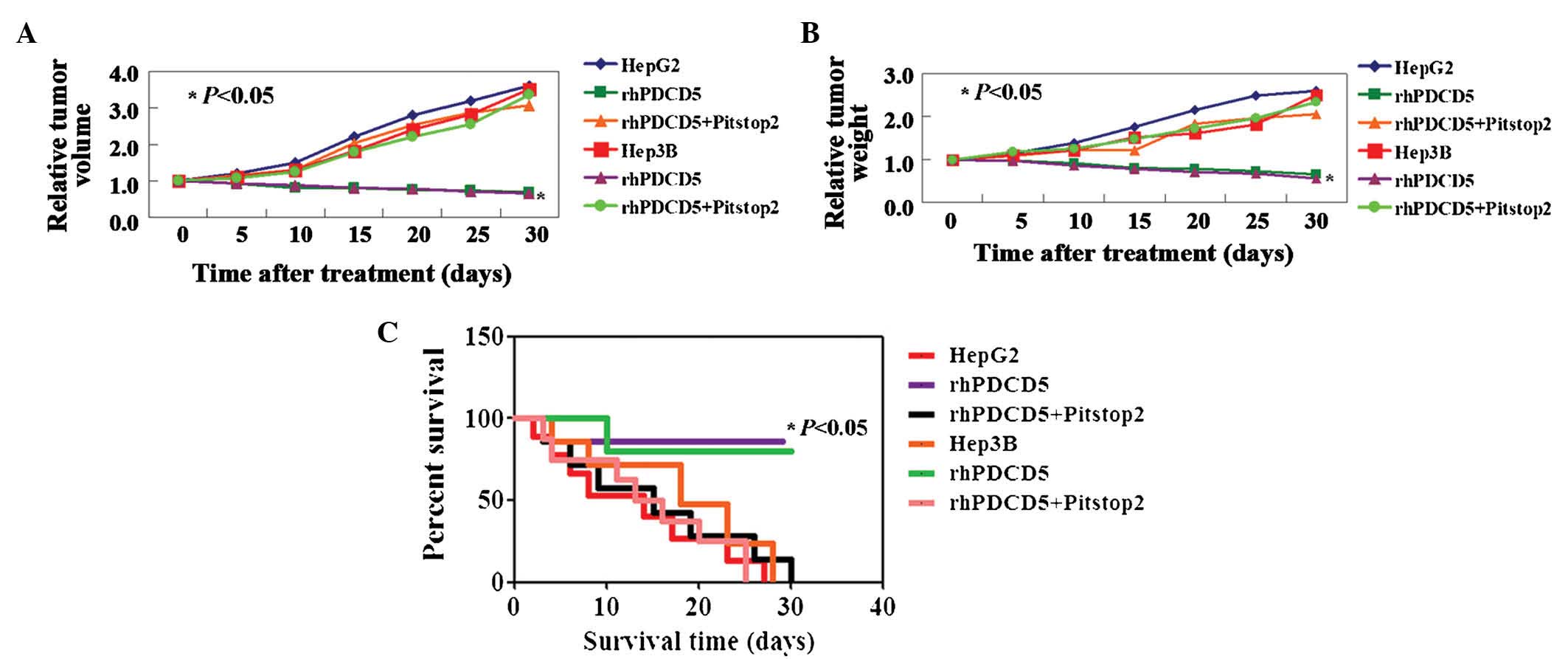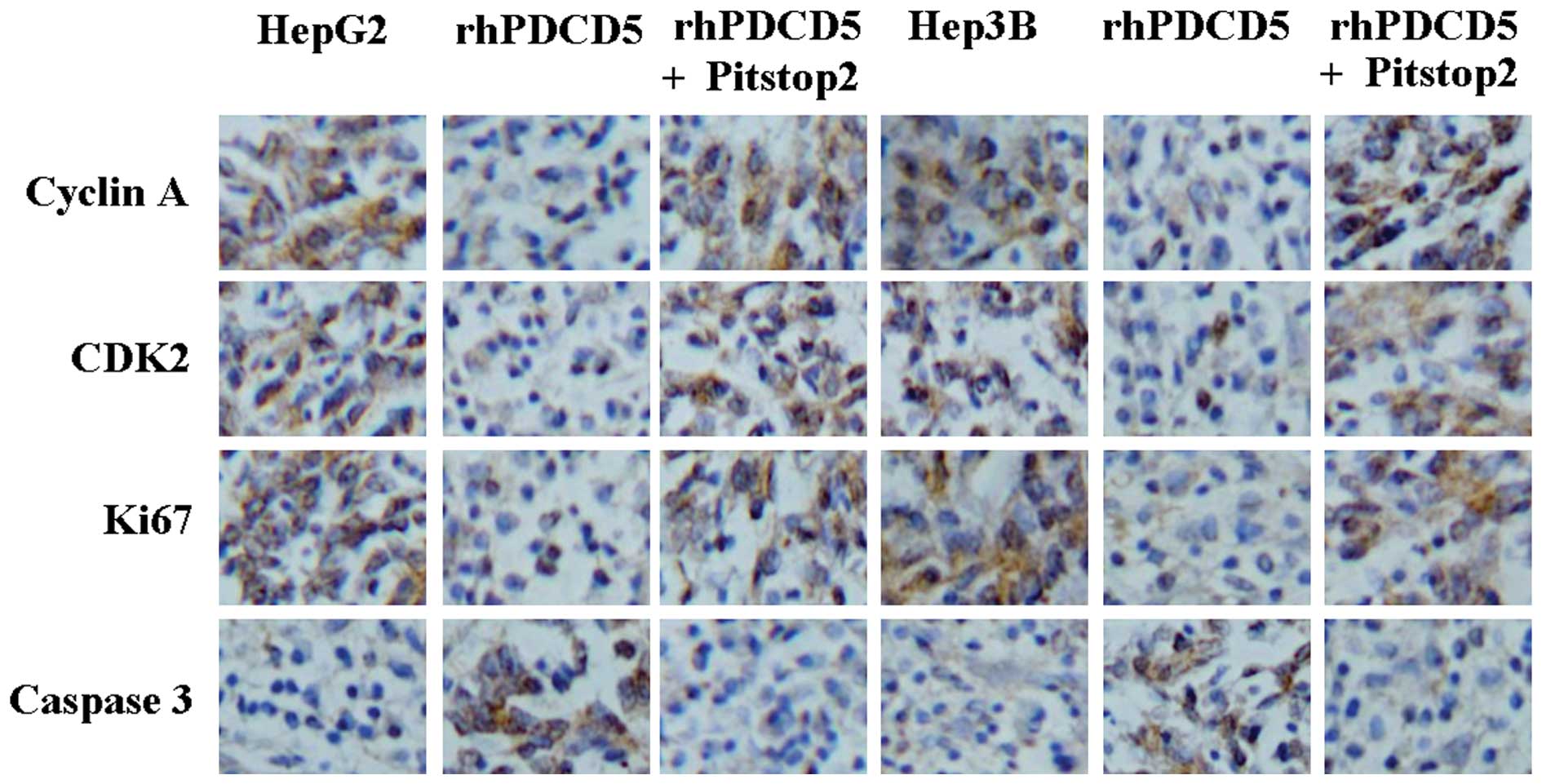Recombinant human PDCD5 exhibits an antitumor role in hepatocellular carcinoma cells via clathrin‑dependent endocytosis
- Authors:
- Published online on: October 26, 2015 https://doi.org/10.3892/mmr.2015.4489
- Pages: 8135-8140
Abstract
Introduction
Hepatocellular carcinoma (HCC) is the fifth most common type of malignancy in men worldwide (1). Its occurrence has a clear geographical distribution, with the highest incidence in East Asia and sub-Saharan Africa (2). Determining the molecular mechanisms underlying the pathogenesis of HCC is important for early detection and treatment.
Programmed cell death 5 (PDCD5), also designated TF-1 cell apoptosis-related gene-19 (TFAR19), was identified in TF-1 cells undergoing apoptosis (3). Decreased expression of PDCD5 has been characterized in human tumors, including breast cancer (4), gastric cancer (5), and hepatocellular carcinoma (6). Recombinant human PDCD5 (rhPDCD5) has been shown to enter a variety of cells by clathrin-independent endocytosis (CIE) (7,8). Endocytosis is a process used by cells to communicate between their interior and the surrounding environment (9). Although CIE has been characterized in numerous cell types and multiple pathways, few studies have demonstrated the roles of CIE in HCC cells. Clathrin is a protein complex of three identical 190 kDa clathrin heavy chains arranged in a trimer (10). Dutta et al (11) showed that CIE of two different cargo proteins, clathrin heavy chain and amphiphysin, was inhibited by Pitstop2.
This study, aimed to use Pitstop2 to block clathrin-dependent endocytosis (CDE) in order to examine the effects of blocking CDE on the antitumor roles of rhPDCD5 in HCC cells.
Materials and methods
Blood samples and measurement of PDCD5 in the serum
All patients approved the use of blood samples for clinical research and the study was approved by the Ethical Committee of the China Medical University (Shenyang, China). Peripheral blood was obtained from 32 patients undergoing surgical resection of primary HCC without previous chemotherapeutic treatment or radiotherapy at the Department of General Surgery, First Affiliated Hospital of China Medical University between January 2009 and December 2011. Preoperative and postoperative samples were clotted for 30 min and then centrifuged for 10 min at 1,000 x g. The concentration of PDCD5 in the serum was assayed using an enzyme-linked immunosorbent assay (ELISA) kit for PDCD5 (USCN Life Science Inc., Houston, TX, USA).
Cell culture
HepG2 and Hep3B human liver cancer cell lines (American Type Culture Collection, Manassas, VA, USA) were cultured in Dulbecco's modified Eagle's medium (Hyclone, Logan, UT, USA) containing 10% fetal bovine serum (Gibco, Thermo Fisher Scientific Inc., Waltham, MA, USA) and incubated in a 5% CO2 incubator at 37°C.
3-(4,5-dimethylthiazolyl)-2,5-diphenyltetrazoliumbromide (MTT) assay
Cell viability was assayed using MTT assays (Sigma-Aldrich, St. Louis, MO, USA). Briefly, cells were plated in 96-well plates (1,500 cells/well). After 24 h, cells were treated with various concentrations of rhPDCD5 protein (0, 5, 10, 20 and 40 µg/ml). After 24 h, 0.5 mg/ml MTT was added to each well. After 4 h, cells were lysed with dimethyl sulfoxide (DMSO; Sigma-Aldrich) and absorbance rates were measured at 550–560 nm using a microplate reader (Bio-Rad 3550; Bio-Rad, Hercules, CA, USA).
Pitstop2 inhibition assay
Cells were incubated with 30 mM Pitstop2 (Abcam, Cambridge, UK) for 15 min at 37°C. Cells were then incubated for an additional 15 min at 37°C in fresh medium.
Cell apoptosis assay and cell cycle assay
For the apoptosis assay, 5×105 cells were collected without EDTA and washed with phosphate-buffered saline (PBS). Then, 500 µl binding buffer, 5 µl Annexin V-fluorescein isothiocyanate (FITC) and 5 µl propidium iodide (PI; KeyGen, Nanjing, China) were added to the suspension and mixed at room temperature in the dark for 10 min. Examination was performed by flow cytometry (FACSCanto II; BD Biosciences, Baltimore, MD, USA). For the cell cycle assay, cells were treated and then collected by trypsinization (trypsin/EDTA; KeyGen). After washing with PBS three times, the cell suspension was fixed with 70% ethanol and incubated with RNAse A (Beyotime Institute of Biotechnology, Haimen, China) at 37°C. Cells were stained with 400 µl PI and the suspension was evaluated by flow cytometry.
Endocytosis assay
FITC labeling of recombinant PDCD5 protein was conducted as described previously (7). Cells were detached from the dish with 5 mM EDTA and incubated with 1 µM rhPDCD5-FITC for 30 min at 37°C. The cells were fixed with 4% paraformaldehyde for 30 min. Then, cells were washed in PBS, mounted in FluoroGuard (Bio-Rad), and observed using a confocal laser-scanning microscope (Leica TCS4D; Leica Microsystems, Oberkochen, Germany).
Transmission electron microscopy
Cells were immersed in 2% cacodylate-buffered glutaraldehyde (Sigma-Aldrich), rinsed in cacodylate buffer supplemented with 15% sucrose, post-fixed with 1% phosphate-buffered OsO4, dehydrated with alcohol, clarified in propylene oxide, and embedded in Epon using flat molds. Ultrathin sections were made with an ultra-microtome and stained with uranyl acetate and a saturated solution of bismuth subnitrate. They were then observed under a JEOL JSM 6400 scanning electron microscope (JEOL, Tokyo, Japan).
In vivo effects of rhPDCD5 on liver cancer xenografts
The Ethics Committee of the China Medical University (Shenyang, China) approved the protocol of the present study. NOD SCID mice (age, 4–6-weeks; NOD.CB17-Prkdcscid/NcrCrl) were obtained from the Charles River Laboratories (Wilmington, MA, USA). Throughout the experiment, mice were housed in groups of three in a room with controlled temperature (22°C) and humidity (50%) under a 12-h light/dark cycle. Standard rat chow (BetterBiotechnology Co., Ltd. Nanjing, China) and tap water were available ad libitum. HepG2 or Hep3B cells (3×107 cells in 200 µl PBS) were injected subcutaneously into the axilla. After the tumor diameters reached 3–5 mm, the mice were divided randomly into three groups [HepG2, rhPDCD5 (40 µg/ml) and rhPDCD5 (40 µg/ml) + Pitstop2 (30 mM)] and received a 100 µl intratumoral injection of PBS, rhPDCD5 or rhPDCD5 + Pitstop2. The tumors were resected, and the tumor weight and volume were determined at 0, 5, 10, 15, 20, 25 and 30 days. Tumors were measured using calipers (Kraftwelle, Hangzhou, China), and tumor volumes were calculated using the following formula: Tumor volume = length x width2 x 0.52. Mice (n=180) were used to establish xenografts for observing survival time (30 mice in each treatment group). The survival status of the mice was observed; all mice had died at day 30, at which the experiment was terminated.
Immunostaining
For immunohistochemical staining, endogenous peroxidase activity was blocked with 3% hydrogen peroxide for 30 min in the tumor sections. Antigen retrieval was performed in citrate buffer (10 mM, pH 6.0) for 30 min at 95°C in a pressure cooker. Primary antibodies (Santa Cruz Biotechnology Inc., Santa Cruz, CA, USA) were incubated with sections at 1:100 dilution overnight at 4°C. The following primary antibodies were used: cyclin A (rabbit polyclonal IgG; cat no. sc-751); CDK2 (rabbit polyclonal IgG; cat no. sc-163); Ki67 (goat polyclonal IgG; cat no. sc-7846) and caspase 3 (rabbit polyclonal IgG; cat no. sc-7148). Sections were then incubated with a biotinylated secondary antibody (mouse anti-rabbit IgG, cat. no. sc-2491; mouse anti-goat IgG, cat. no. sc-53799; Santa Cruz Biotechnology Inc.) for 1 h at room temperature, followed by incubation with a streptavidin horseradish peroxidase complex (Beyotime Institute of Biotechnology) for 1 h at room temperature. Bound antibody was visualized with 3,3′-diaminobenzidine tetrahydrochloride (Beyotime Institute of Biotechnology). Sections were counterstained with hematoxylin (Beyotime Institute of Biotechnology).
Statistical analysis
Statistical analyses were performed using SPSS 15.0 software (SPSS, Inc., Chicago, IL, USA). Values are presented as the mean ± standard deviation. Statistical significance was calculated with a Mann-Whitney-Wilcoxon statistical test. The Kaplan-Meier estimator was used to compare different groups, and P-values were calculated using the log-rank (Mantel-Cox) test. P<0.05 was considered to indicate a statistically significant difference between values.
Results
Preoperative and postoperative serum levels of PDCD5 detection in patients with HCC
Preoperative serum levels of PDCD5 protein in the patients with HCC were significantly lower than the postoperative serum levels (Fig. 1A, P<0.05). Moreover, the serum PDCD5 levels were significantly correlated with portal invasion (P=0.0003) and lymph node metastasis (P=0.0103) (Table I). Patients with HCC with high serum levels of PDCD5 expression were associated with a significantly higher survival rate compared with those with low serum PDCD5 expression (Fig. 1B, P=0.038).
Table ICorrelation between postoperative serum PDCD5 with demographic and biological parameters in 32 hepatocellular carcinoma samples. |
rhPDCD5 exhibits antitumor activity in HCC cells by CDE
An MTT assay showed that the proliferation rate of cells treated with rhPDCD5 was decreased compared with the untreated cells (Fig. 2A, P<0.05). In addition, the IC50 value for rhPDCD5 was 40 µg/ml for HepG2 and Hep3B cells. The results of Annexin V-FITC and PI double staining showed that the apoptotic ratio was 10–20 times higher in rhPDCD5 treated cells compared with untreated cells (Fig. 2B). PI staining revealed that HCC cells with rhPDCD5 treatment were arrested in S phase (Fig. 2C). The antitumor effects of rhPDCD5 were offset using Pitstop2. It was hypothesized that rhPDCD5 exhibits antitumor activity in HCC cells due to CDE. With Pitstop2 treatment, fluid phase pinocytosis in liver cancer cells was almost completely inhibited, and rhPDCD5 internalization was reduced (Fig. 2D). Using electron microscopy, the cytoplasmic face of the plasma membrane was examined following Pitstop2 treatment. It was confirmed that rhPDCD5 internalization was inhibited by Pitstop2 (Fig. 2E).
rhPDCD5 has a prominent antitumor effect in vivo
As shown above, rhPDCD5 exhibits an inhibitory effect on liver cancer cell activity in vitro. Therefore, in this study, the antitumor properties of rhPDCD5 were further evaluated using xenograft tumor models. A significant inhibition of tumor volume was observed in tumor cells treated with rhPDCD5, while no effects of rhPDCD5 on HCC cells were observed with Pitstop2 treatment (Fig. 3A). Correspondingly, the weights of untreated, rhPDCD5, and rhPDCD5+Pitstop2-treated tumors followed the same trend at day 5 (448±13, 215±14 and 452±21 mg, respectively) (Fig. 3B, P<0.05). In addition, the survival rate of mice with tumors treated with rhPDCD5 was significantly increased (Fig. 3C, P<0.05).
Mechanism(s) of rhPDCD5 in the mouse xenograft model
In order to identify the mechanism underlying the effect of rhPDCD5, protein expression of cyclin A, CDK2, Ki67 and caspase3 was detected by immunostaining. A decrease in cyclin A, CDK2, and Ki67 protein, and an increase in caspase3 protein levels was identified in the tumor tissues of the mice treated with rhPDCD5 (Fig. 4). Compared with untreated tissue, no changes of these proteins were observed in the tumor tissues from the mice treated with rhPDCD5+Pitstop2 (Fig. 4).
Discussion
PDCD5 is an apoptosis-related gene cloned from TF-1 cells undergoing cytokine deprivation-induced apoptosis (3). In a study by Wang et al (12), no statistically significant difference was observed between the serum PDCD5 concentrations in healthy patients and the patients with breast cancer, gastrointestinal cancer or lung cancer. In this study, it was demonstrated that preoperative serum levels of PDCD5 protein in the patients with HCC were significantly lower than the postoperative serum levels.
Wang et al (7) found that exogenous addition of hrPDCD5 to the culture medium of TF-1 cells or HL-60 cells can enhance programmed cell death triggered by growth factor deprivation in TF-1 cells or serum deprivation in HL-60 cells. Notably, it was observed that rhPDCD5 could induce apoptosis and S phase arrest in HCC cells. Certain previous studies have demonstrated that PDCD5 is not only an apoptotic accelerator but also an apoptotic trigger (6,13). rhPDCD5 has been shown to enter a variety of cells by CIE and exert biological activities (7,8). However, in this study, it was found that inhibition of clathrin could inhibit rhPDCD5 internalization. Clathrin is a protein complex of three identical 190 kDa clathrin heavy chains arranged in a trimer of three 'legs' connected by their C-termini at a central vertex (10,14). This study used the clathrin inhibitor, Pitstop2, to demonstrate rhPDCD5 internalization via CDE.
In conclusion, the principal findings of this study are that: i) Preoperative serum levels of PDCD5 protein in patients with HCC were significantly lower than postoperative serum levels; ii) the serum PDCD5 levels were correlated statistically with portal invasion, lymph node metastasis and patient prognosis; iii) rhPDCD5 could inhibit cell proliferation, induce apoptosis and S phase arrest in HCC cells and suppress tumor growth in established xenograft tumor models; and iv) the antitumor roles of rhPDCD5 in HCC cells occur through CDE. The present study provided a theoretical basis for the clinical use of rhPDCD5 for the treatment of HCC patients. Further study of the effects of rhPDCD5 for the treatment of other types of cancer is also an area of great interest.
Acknowledgments
The authors would like to thank Dr Miao Yu (Science Experiment Center, China Medical University, Shenyang, China) for technical assistance.
References
|
Jemal A, Bray F, Center MM, Ferlay J, Ward E and Forman D: Global cancer statistics. CA Cancer J Clin. 6:69–90. 2011. View Article : Google Scholar | |
|
El-Serag HB: Hepatocellular carcinoma. N Engl J Med. 365:1118–1127. 2011. View Article : Google Scholar : PubMed/NCBI | |
|
Liu H, Wang Y, Zhang Y, Song Q, Di C, Chen G, Tang J and Ma D: TFAR19, a novel apoptosis-related gene cloned from human leukemia cell line TF-1, could enhance apoptosis of some tumor cells induced by growth factor withdrawal. Biochem Biophys Res Commun. 254:203–210. 1999. View Article : Google Scholar : PubMed/NCBI | |
|
Hedenfalk I, Duggan D, Chen Y, Radmacher M, Bittner M, Simon R, Meltzer P, Gusterson B, Esteller M, Kallioniemi OP, et al: Gene-expression profiles in hereditary breast cancer. N Engl J Med. 344:539–548. 2001. View Article : Google Scholar : PubMed/NCBI | |
|
Yang Y, Zhao M, Li WM and Lu YY, Chen YY, Kang B and Lu YY: Expression of programmed cell death 5 gene involves in regulation of apoptosis in gastric tumor cells. Apoptosis. 11:993–1001. 2006. View Article : Google Scholar : PubMed/NCBI | |
|
Fu DZ, Cheng Y, He H, Liu HY and Liu YF: PDCD5 expression predicts a favorable outcome in patients with hepatocellular carcinoma. Int J Oncol. 43:821–830. 2013.PubMed/NCBI | |
|
Wang Y, Li D, Fan H, Tian L, Zhong Y, Zhang Y, Yuan L, Jin C, Yin C and Ma D: Cellular uptake of exogenous human PDCD5 protein. J Biol Chem. 281:24803–24817. 2006. View Article : Google Scholar : PubMed/NCBI | |
|
Wang Y, Shi L, Song Q, Zhang M, Lou Y, Zeng Y, Ma D, Wang Y and Ke X: Recombinant human PDCD5 protein enhances chemosensitivities of hematologic malignancies. Chin Sci Bull. 54:3981–3990. 2009. View Article : Google Scholar | |
|
Doherty GJ and McMahon HT: Mechanisms of endocytosis. Annu Rev Biochem. 78:857–902. 2009. View Article : Google Scholar : PubMed/NCBI | |
|
Royle SJ: The cellular functions of clathrin. Cell Mol Life Sci. 63:1823–1832. 2006. View Article : Google Scholar : PubMed/NCBI | |
|
Dutta D, Williamson CD, Cole NB and Donaldson JG: Pitstop 2 is a potent inhibitor of clathrin-independent endocytosis. PLoS One. 7:e457992012. View Article : Google Scholar : PubMed/NCBI | |
|
Wang Y, Wang GH and Zhang QY: Determination of PDCD5 in peripheral blood serum of cancer patients. Chin J Cancer Res. 23:224–228. 2011. View Article : Google Scholar : PubMed/NCBI | |
|
Han XR, Sun Y and Bai XZ: The anti-tumor role and mechanism of integrated and truncated PDCD5 proteins in osteosarcoma cells. Cell Signal. 24:1713–1721. 2012. View Article : Google Scholar : PubMed/NCBI | |
|
Fotin A, Cheng Y, Sliz P, Grigorieff N, Harrison SC, Kirchhausen T and Walz T: Molecular model for a complete clathrin lattice from electron cryomicroscopy. Nature. 432:573–579. 2004. View Article : Google Scholar : PubMed/NCBI |













